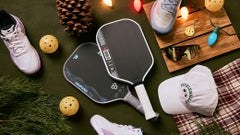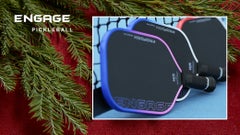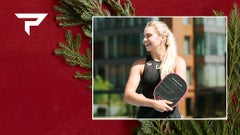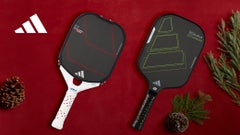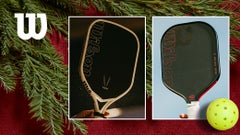The Most Important Shot in Pickleball
Do you want to know what is arguably the most important shot in pickleball? If that is the case, and you also want to improve this particular shot, then please read on! Let's dive in to it.
Since Pickleball Warehouse (called Total Pickleball at the time) opened in 2017 the undeniable fun of the sport has had a noticeable and positive impact on the entire Sports Warehouse family. Our team of playtesters and staff of avid picklers are as passionate about helping others improve their skill set as they are when it comes to accurate equipment descriptions. We hope this article makes playing pickleball even more fun by helping reduce the time it can take to refine and add to your arsenal of shots.
What is the Most Important or Best Shot in Pickleball?
The shot that ends the point, game or tournament on favorable terms is the most celebrated and often perceived as the best shot of the moment. However, the shot, or shots, that lead to the winning result are just as or even more important.
The Serve is the First Shot, but is it the Most Important?
Technically the first domino in pickleball is the serve, and no doubt serve quality is vital to surviving points long enough to win them. The serve is an important part of point construction, whether it is for doubles or singles, and any player striving to improve will experience benefits from practicing this shot.
That said, particularly in doubles, there are three distinct advantages afforded to the returning team, and ideally you want make the most of them with a high quality return of serve.
1. (Strictly doubles) The non-returning player is positioned in front of the baseline, near the kitchen before the point begins.
2. (Both doubles and singles) For a brief moment, if properly struck, the return of serve allows singles players to follow in behind the shot before the third shot occurs, and it gives the doubles player who's hitting the return a chance to move forward and establish a dominant position before the third shot is hit.
3.) (Both doubles and singles) The server must wait for the return of serve to bounce before playing the third shot.
Why the Return is the Most Important Shot
As a result we feel that the return of serve is the most important shot to execute well in pickleball and one of the best indicators of how the point will go. Not because a return can be struck harder than the serve, but because the server must wait for the return (second shot) to bounce before taking action on the third. Depending on the depth of the return, points will develop differently.
Should You Vary the Return of Serve When Playing Doubles or Singles?
Most players probably change their return of serve more due to windy conditions rather than switching from playing singles to doubles. The other common reason to vary where the return lands relates whether the opposing team or player has an obvious weakness.
Should I Always Aim a Return Deep?
Percentage wise, yes! Variety may be the spice of life, but in pickleball consistent, deep returns are your "meat and potatoes" option. Percentage wise, a deep return will more often reap a better result compared to landing them short. Deep returns, if not hit too offensively, buy time so the returner can come in behind it and quickly assume a dominate position at the kitchen line. This maximizes the pressure you can apply on the server or serving team. The one caveat I can add is this: If the conditions are windy, don’t aim for the lines. Instead get you and your partner in the point with a safer return, even if you have to sacrifice some shot depth.
High, Low, Fast or Slow?
When it comes to the getting the most out of a service return there are several things to consider. Hitting the return offensively with some authority can be a good idea. It puts pressure on your opponents because they have less time to react. However, less time for your opponents also means less time for you to approach the kitchen line.
Ideally, you want the return to land in a spot of the service area that does not invite your opponents to approach the kitchen early. And returned at a speed that allows you to get in close to the NVZ before the third shot leaves their paddles.
Lastly, consider the wind. In blustery conditions it is sometimes a fine line between returning the ball so softly that it veers off course, and ironically hitting too hard can cause the same thing. We find that erring slightly on the side of hitting the return of serve with authority, instead of lofting it slowly, works better in the wind.
Where Should I Stand to Return?
There is no one way that delivers a 100 percent success, but many experienced players agree that regardless of your starting position, taking a step toward the serve’s bounce is the best way to return a serve. If you know how a particular player is going to serve, then for sure it is a good idea to make an adjustment. If that is not the case, we advocate standing close to the baseline for a proper return of serve positioning.
Option 1: Hitting the return closer to the bounce potentially accomplishes three benefits: Moving toward the bounce creates natural momentum toward the kitchen, takes time away from the opposition and improves your court position. There is a potential fourth benefit as well. In windy conditions hitting the return closer to the bounce helps minimize the unpredictable effect the wind has on a pickleball.
Option 2: Another strategy is to start farther back instead of hugging the baseline, which gives the returner more time to react. Often this means the returner is making contact with the ball after the bounce has reached its peak height and is dropping. This approach is effective for most players – just make sure you are coming in behind the return and not stuck replying to the third shot from the backcourt. If there is a lot of action and pace on a serve, standing a little behind the baseline and waiting for the ball’s spin to dissipate is a reliable way to harness tough service deliveries.
What do the Pros do?
As far as professional doubles and mixed doubles, the most common theme is to move forward as the return is struck. For singles, the men are most always moving forward behind the return, and it looks like a 50/50 split in terms of the pro women rushing the net in singles or hanging on the baseline after hitting a return.
In Conclusion
Overall, pickleball is about having fun, and with some improvements mixed in, we feel makes playing pickleball even more so! Not to be the party pooper, but no matter how good your return of serve becomes, it will never win you a single point due to the sport's side-out scoring system. Improving your return off of both wings will, however, put you and your teammate on a path of being able to better force the action, dictate play and minimize the shot options available for the other team. Or in other words, earns you a chance to serve for a point!




